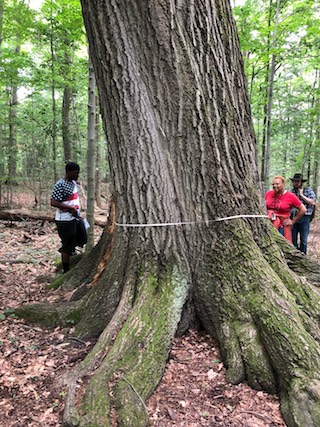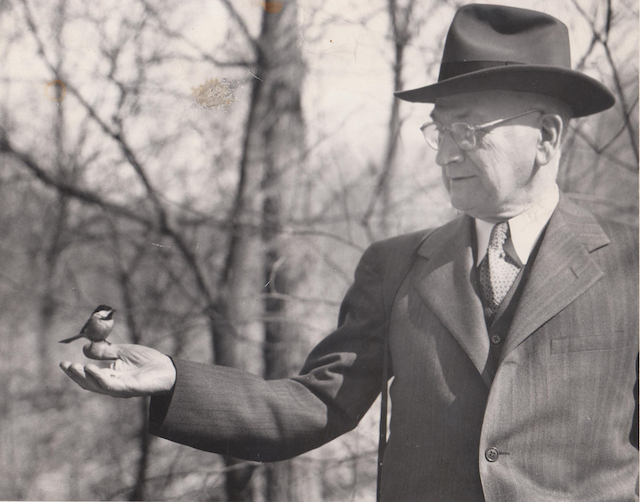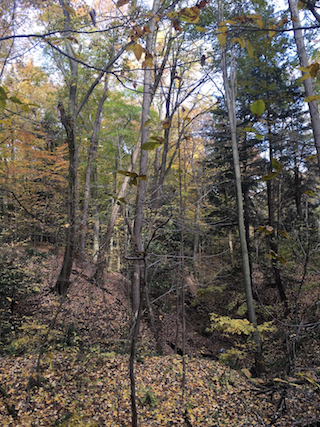 A group of tenth graders from Cleveland’s JFK E3gle Academy slows to a halt as one of the students bends to pick up a giant, tulip-shaped leaf from the forest floor.
A group of tenth graders from Cleveland’s JFK E3gle Academy slows to a halt as one of the students bends to pick up a giant, tulip-shaped leaf from the forest floor.
“Look, it is simple and lobed,” she says, recalling the lesson on tree species identification that her class received before its field trip to the A.B. Williams Memorial Woods, a 65-acre Beech-Maple climax forest located in the North Chagrin Reservation of the Cleveland Metroparks.
Four groups of eight students, with Museum educators as their guide, are fanning out to complete their assignment, which is to walk in the footsteps of former Metroparks naturalist and Cleveland Museum of Natural History Curator of Education, Arthur Baldwin Williams.
The field trip is just one component of a program called Discover – Explore – Connect: Engaging with the Environment through Historical Records in the Natural Sciences – a collaborative effort to connect students with primary research resources and advance our understanding of the natural world. Thanks to a grant from the National Historical Publications and Records Commission, Museum Librarian and Archivist Wendy Wasman and researchers at Baldwin-Wallace College were able to pursue an opportunity to convert paper field notes and research to a digital archive that would be accessible online. For the collaborators, the obvious choice was the notes of A.B. Williams.
Preserving a Legacy
A.B. Williams was a scientist and an educator who led groups of students on nature hikes from the former Trailside Museum, which he established near the current A.B. Williams Memorial Woods.. At least once a week from 1930 to 1950, Williams walked the woods and recorded species, the location and condition of trees that were 9 inches or greater in diameter, as well as the arrival dates of migratory birds and wildflower phenology, amassing a huge collection (2.5 linear feet measured by height) of field notes, photographs, maps, sketches, writings and other archival material. This treasure trove of naturalist data could only be found in its original form in the Museum’s archive for decades – until now.

“All of these years, the Williams archive was hidden away in boxes,” Wasman says, “now it’s searchable in a way that won’t degrade the primary resource.” Digitizing the Williams field notes not only helps keep his original handwritten documents intact, but also makes his research widely available to other scientists, such as Baldwin Wallace Associate Professor of Biology, Kathryn Flinn and Ph.D. candidate in Biology at University of Akron, Ryan Trimbath. When Williams’ notes were made available online this spring, Flinn and her graduate assistants used it to complete a re-survey of the trees in A.B. Williams Memorial Woods. Trimbath, meanwhile, is connecting with the Williams data on the distribution of trees to complete his Thesis on the succession of a climax forest beset by challenges like Beech leaf disease.
Importantly, the notes' accessibility also provided new opportunities for engaging school-age students in science and nature.
Deepening Connections Between Past and Present for a Better Future
In order to make the archival material come alive for young audiences, Wasman worked with Trimbath and Museum educator, Skye Powers-Kaminski, in writing a curriculum for middle, high school and outdoors educators. The lessons range from working with primary sources in identifying species of wildflowers to writing about Williams’ poetic journal, The Fallen Tree, a seventeen-year eyewitness account of one tree’s natural cycle of decay and regeneration.
“I hope the curriculum will be a springboard for many educators to incorporate natural history into their classrooms,” Trimbath said. “I have had the opportunity to work with students in formal education settings, from preschool to upper-level college undergraduate and graduate students. One thing is clear. We all have something to learn about nature, whether it is the name of a species or a deep understanding of why we see certain patterns in natural communities.”
“For our children to be future-ready learners, they need to have a solid understanding of the past and how we have come to be where we are today,” added Powers-Kaminski. “I loved that we were able to take a group of students out into the field to replicate some of the work A.B. Williams completed during his career.”
The students of JFK E3gle are the first to connect this intimately with Williams’ legacy. Their experience began when instructor Sheila Hughes attended a teacher workshop at the Museum for the Discover - Explore - Connect curriculum. It inspired her to teach Williams’ field observations of Moses Cleaevland trees in her Ecology class. Tying in literary sources, such as Maya Angelou’s poem “When Great Trees Fall” and visual aspects, like a Forest Challenge card game that the Museum had previously collaboratively produced, had a remarkable impact on memory retention, she said.
“To close the gap between class and field trip, we sketched, read and discussed the poem, went online and investigated and found the website that ties it all together,” Hughes said, referring to the project website which includes a blog ‘authored’ by Williams. His journal and his weekly nature column that ran for many years in The Cleveland Press newspaper are the source material. “I was amazed at how much they absorbed. Now they can go to any park, use it and benefit.”
 The students then took a Museum workshop on how to reference Williams’ notes and use the tools he used: a dichotomous key to identify tree species, Biltmore sticks to measure tree diameter, and paper and pencil to draw pictures and maps. The next step was to walk the same forest Williams walked and made observations in for decades.
The students then took a Museum workshop on how to reference Williams’ notes and use the tools he used: a dichotomous key to identify tree species, Biltmore sticks to measure tree diameter, and paper and pencil to draw pictures and maps. The next step was to walk the same forest Williams walked and made observations in for decades.
The students spend the day hiking and observing the conditions of the climax forest community, which they learn remains relatively unchanged until it is destroyed by an event such as a fire or human interference. The beech and maple trees are still abundant, the students found when comparing data from Williams’ sound maps. Using his bird survey technique that became an ornithological standard, however, showed that nesting pairs of warblers and migratory birds have declined. The trip is an important snapshot of the woods.
“The field trip was breathtaking,” said JFK E3gle Academy student, Johnyce Keith. “You can see how some trees are dying off and other trees (are) growing. I feel as if I was walking on his path. Like what he did was awesome. The outdoors are super exciting. I could do more.”
“The goal was discovering primary sources of information and archives,” said Wasman, “to connect it from the past to the present, so, you’re seeing (ecological) changes. The very nature of science is to question what came before.”